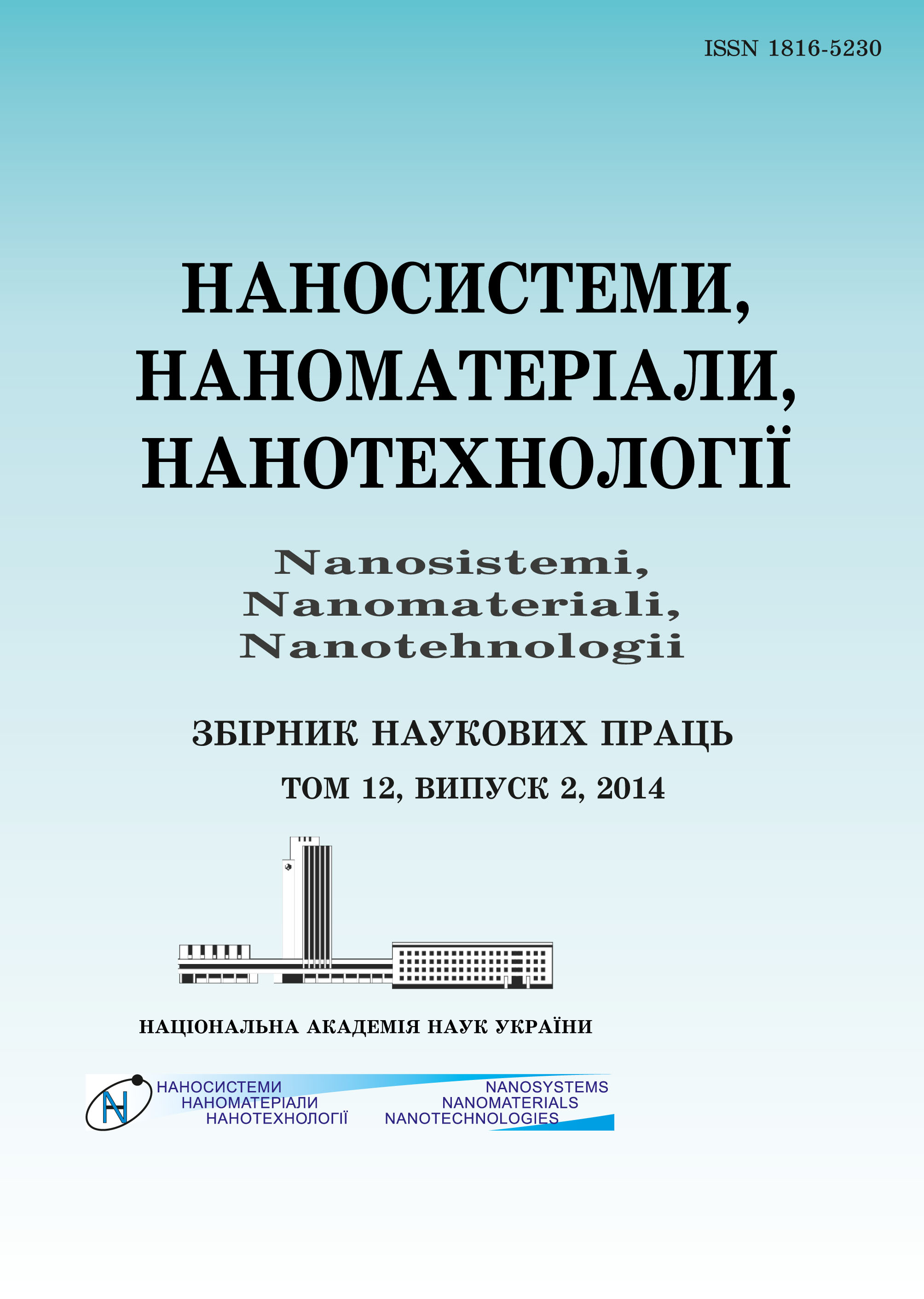|
|
|||||||||
 |
Year 2021 Volume 19, Issue 1 |
|
|||||||
|
|||||||||
Issues/2021/vol. 19 /Issue 1 |
S. P. Repetsky, A. V. Andrusyshyn, G. M. Kuznetsova, R. M. Melnyk, V. K. Rybalchenko
«Models of Nanocomplexes Based on C60 Fullerene for Creation of Anticancer and Anti-Inflammatory Agents»
0215–0219 (2021)
PACS numbers: 36.40.Mr, 61.46.Bc, 61.48.De, 81.05.ub, 87.15.ag, 87.64.Aa, 87.85.Qr
Based on the quantum-chemical method of molecular orbitals, implemented in the Gaussian 09w software package, a method of modelling nanocomplexes for creation of antitumour and anti-inflammatory medicines is developed. The object of study is a complex of C60 fullerene and antitumour agent 1-(4-C1-benzyl)-3-C1-4-(CF3-phenylamino)-1H-pyrrole-2,5-dione (abbreviated as MI-1). Each detached part, C60 and MI-1, has a therapeutic effect. The main antitumour and anti-inflammatory action relies on MI-1 compound. It is found that the nanocomplex of C60 fullerene with MI-1 is stable at human-body temperature. The nanocomplex is able to serve as a vehicle of medicines to the tumour tissue and dissociate in the tumour due to its low pH (higher acidity) compared to healthy tissue and exhibit therapeutic properties of individual components.
Keywords: modelling of nanocomplexes, quantum-mechanical methods, anticancer and anti-inflammatory agents, fullerene, pyrrole derivative
https://doi.org/10.15407/nnn.19.01.215
References
1. S. Reuter, S. C. Gupta, M. M. Chaturvedi, and B. B. Aggarwal, Free Radic.Biol. Med., 49, No. 11: 1603 (2010); https://doi.org/10.1016/j.freeradbiomed.2010.09.0062. Zh. Wang, Zh. Li, Ya. Ye, L. Xie, and W. Li, Oxid. Med. Cell Longev.,2016: 7891574 (2016); http://dx.doi.org/10.1155/2016/7891574
3. A. Medhat, S. Mansour, S. El-Sonbaty, E. Kandil, and M. Mahmoud, TumourBiol., 39, No. 7: 1010428317717259 (2017); https://doi.org/10.1177/1010428317717259
4. I. V. Byelinska, H. M. Kuznietsova, N. V. Dziubenko, O. V. Lynchak,Yu. I. Prylutskyy, O. A. Kyzyma, O. Ivankov, V. K. Rybalchenko, andU. Ritter, Mat. Sci. Eng. C, 93: 505 (2018); https://doi.org/10.1016/j.msec.2018.08.033
5. O. V. Lynchak, Yu. I. Prylutskyy, V. K. Rybalchenko, O. A. Kyzyma,D. Soloviov, V. V. Kostjukov, M. P. Evstigneev, U. Ritter, and P. Scharff,Nanoscale Res. Lett., 12, No. 8: 1 (2017); https://doi.org/10.1186/s11671-016-1775-0
6. S. V. Prylutska, O. P. Matyshevska, I. I. Grynyuk, Yu. I. Prylutskyy,U. Ritter, and P. Scharff, Mol. Cryst. Liq. Cryst., 468, No. 1: 265 (2007); https://doi.org/10.1080/15421400701230105
7. A. Montellano, T. Da Ros, A. Bianco, and M. Prato, Nanoscale, 3: 4035(2011); doi:10.1039/c1nr10783f
8. C.-M. Lin, and T.-Y. Lu, Recent Patents on Nanotechnology, 6: 105 (2012);doi:10.2174/187221012800270135
9. M. M. M?drek, F. Plucinski, and A. P. Mazurek, Acta Poloniae Pharmaceu-tica – Drug Research, 70, No. 4: 659 (2013); https://www.ptfarm.pl/download/?file=File%2FActa_Poloniae%2F2013%2F4%2F659.pdf
10. R. R. Panchuk, S. V. Prylutska, V. V. Chumak, N. R. Skorokhyd,L. V. Lehka, M. P. Evstigneev, Yu. I. Prylutskyy, W. Berger, P. Heffeter,P. Scharff, U. Ritter, and R. S. Stoika, J. Biomed. Nanotechnol., 11, No. 7:1139 (2015); https://doi.org/10.1166/jbn.2015.2058
11. H. M. Kuznietsova, O. V. Lynchak, M. O. Danylov, I. P. Kotliar, andV. K. Rybal’chenko, Ukr. Biochem. J., 85, No. 3: 74 (2013); http://dx.doi.org/10.15407/ubj85.03.074
12. H. M. Kuznietsova, M. S. Yena, I. P. Kotlyar, O. V. Ogloblya, andV. K. Rybalchenko, The Scientific World Journal, 2016: 2145753 (2016); http://dx.doi.org/10.1155/2016/2145753
13. J. Foresman and A. Frisch, Exploring Chemistry with Electronic StructureMethods (Wallingford, CT: Gaussian Inc.: 2015).
14. J. L. Wike-Hooley, J. Haverman, and H. S. Reinhold, Radiother. Oncol., 2:343 (1997); https://doi.org/10.1016/S0167-8140(84)80077-8
 This article is licensed under the Creative Commons Attribution-NoDerivatives 4.0 International License ©2003—2021 NANOSISTEMI, NANOMATERIALI, NANOTEHNOLOGII G. V. Kurdyumov Institute for Metal Physics of the National Academy of Sciences of Ukraine. E-mail: tatar@imp.kiev.ua Phones and address of the editorial office About the collection User agreement |